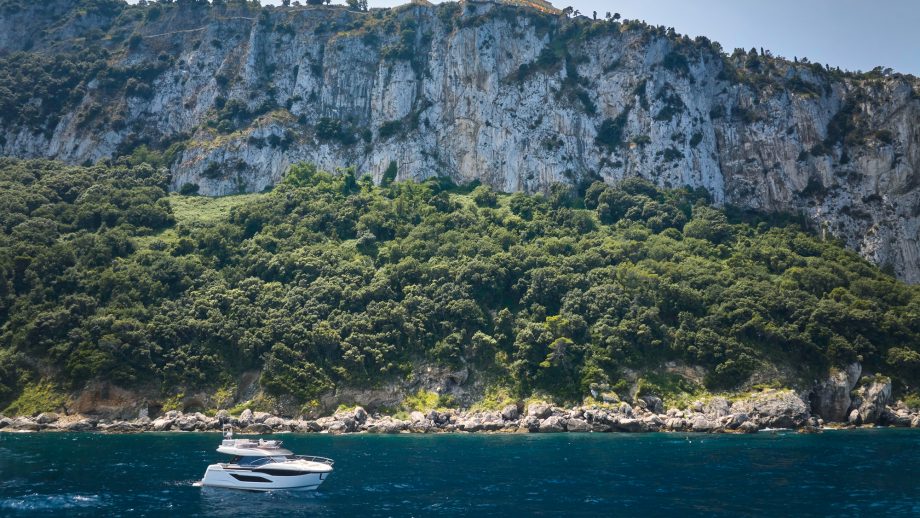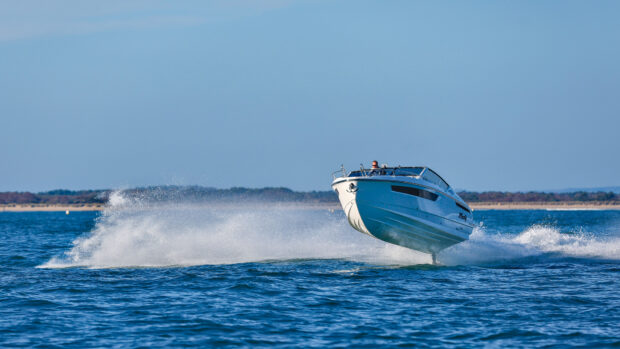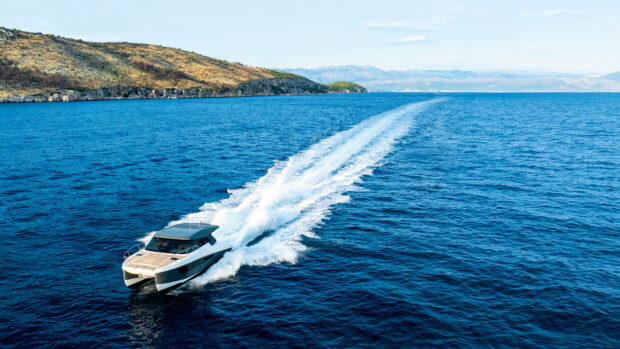The Prestige F4 was one of the busiest boats at the Cannes Yachting Festival in 2023. Alex Smith gets behind the wheel of the 50ft flybridge cruiser that dares to be different
What about Prestige eh? Having turned its attention to the burgeoning multihull sector with a fleet of exciting new powercats, it is aiming to cement its advantage in the 40-60ft flybridge market with a fresh line of monohulls too, including the Prestige F4.
Now given the extraordinary sales success of its previous flybridge models, it would have been perfectly understandable if this new model had shown little but market-savvy tweaks and subtle augmentations, but what Prestige is attempting to do with the new Prestige F4 is clearly much more radical than that.
Decent day spaces
Before we get to the really clever stuff though, let’s take a quick look at the flybridge itself. Accessed via some steep but perfectly navigable steps at the port side of the cockpit, it uses a big forward companion seat opposite a single port helm, with a sun pad that extends well forward of the skipper so four or five friends can join you when it’s your turn at the wheel.
There’s also a basic starboard wet bar with griddle, sink and fridge, plus an L-shaped aft dinette big enough to accommodate six. And if you want a bit of shelter up top, it’s good to see that the Bimini awning also comes with integrated LED strips and a set of sturdy tensioning lines so you can leave it in position even when you’re underway.

The upper deck’s companion seating wraps around the helm
Back down on the main deck, the flybridge’s day spaces are supplemented with triple loungers on the bow’s central island sunbed. There’s an integrated pram hood to help shade you from the sun here too, plus a set of independently adjustable backrests for extra comfort.
But while the skylights remain usefully uncovered even when the sunbeds are occupied, you could argue that these peripheral sections might have been better used as a means of expanding the lounger to accommodate five.

The handling is lots of fun in a moderate, compliant and refined sort of way
That said, there’s plenty going on further aft. The hi-lo swim platform is equipped to carry a 350kg tender and in addition to some handy transom storage, there’s a neat transverse crew cabin, accessed via a hatch on the starboard side.
It’s unlikely many people beyond the charter market will want a skipper on board a boat of this size but it still earns its place as a handy overspill cabin for your noisiest guest or your bulkiest baggage.

The bow lounge comes with backrests, sunshades and cup holders
In terms of the cockpit itself, you can change the fashionable inward-facing sofas for a more traditional L-shaped arrangement. You can opt for an ice-maker beneath the flybridge steps, in place of the test boat’s storage box.
And you can install a third helm position, comprising a joystick and thruster control, in the mouldings at the starboard side of the superstructure. But in truth, it’s difficult to talk meaningfully about the cockpit without also talking about the transverse galley and the internal saloon because the three spaces are very closely integrated.
The Ocean View galley sits at the same level as the external deck, ahead of the cockpit settees, with a massive hatch that opens out into the space. It means you can stand in the galley, face aft and enjoy a pleasant sense of integration with the cockpit diners.
There’s plenty of deck space to arrange a set of stools out here too, so it’s a bit of a shame there’s no fold-out bar to make best use of that. But if you spin around and face forward instead, the deck levels have been arranged so that your eye-line matches that of the seated saloon guests on the other side of the low-level glass screen.

That really is a lovely touch, and when you step down to the cabins, the Prestige F4’s carefully orchestrated deck levels bring even greater rewards…
On a different level
While most flybridge cruisers at this size use a lower deck with three cabins and a pair of bathrooms, the raised bow of the Prestige F4 reveals its big-ticket secret. Instead of sticking the owner’s cabin in the full-beam space amidships or crow-barring it into the tapering bow, they have lifted the height of the foredeck to create more room for a raised forward owner’s cabin above the V of the hull. That does create a step in the sheerline but it’s still a good looking boat and both the privacy and the scale of the forward owner’s cabin are outstanding.
The fact that it occupies a mid-level space, half-way down the steps, engenders a natural sense of separation from the two guest cabins further aft – and that’s a particularly brilliant feature because its elevation feels figurative as well as physical.

A neat little corner table and TV add extra functionality to the saloon dinette
Positioned just a few feet forward of the saloon, almost like the all-singing, all-dancing main deck master cabin on a superyacht, you get a tangible sense that this is the place set aside for the owner and its facilities absolutely back that up.
There’s space for a lovely little settee with a breakfast table against the forward bulkhead at the foot of the bed. There’s also room for an impressive ensuite with twin sinks and a large separate shower on the port side. And there’s uncommonly generous headroom of around 2m in all the key areas.
When you move further aft, down another couple of steps, the day heads (again with separate shower) is as bright and lofty as any we’ve seen on a 50ft flybridge cruiser. It’s well placed for the saloon guests up top too, and when you reach the lowest level, the beam is very simply divided between a starboard double and a port twin.

The diners eye-line is at the same level as those in the galley
Both come with good hanging storage but if you need it, there’s plenty of extra storage available in the transverse corridor, as well as a washer drier in a deceptively large cabinet beneath the steps. The finish is pretty good too.
Notwithstanding a couple of panels that need tightening up, it takes Prestige another step closer to the premium brands and uses every trick in the book to make the space feel as bright and generous as possible. There are elegant inset LEDs, mirrored panels, sliding doors, clever deck level fluctuations and pale woods and fabrics – and it all comes together to create a living environment that’s very tough to fault.
Radical refinement
We know what you’re thinking: all this cleverly integrated forward volume is likely to be a lot less fun at sea. But the idea behind this arrangement is that by raising the point at which the hull sides expand and then lifting the foredeck to cater for that, you’re still able to factor in the finer, softer-riding angles required underway. It makes good theoretical sense and our time among the wake-strewn waters of Palma suggests that it works too.

With its unusual breadth, height, brightness and location, the owner’s cabin is quite a revelation
When you get underway, there’s very little (either in the Prestige F4’s response to a stiff beam wind or in its agile reaction to helming input) to suggest that you’re carrying such a substantial load.
Our tabs are out of action on the day but even when we turn off the Seakeeper, this boat is impeccably behaved. It runs beautifully level at pretty much every speed and remains very relaxed and easygoing, even when we misbehave among the rolling wakes of the Balearic cruise liners. No water breaches the side decks, let alone the flybridge, and the impacts are remarkably soft and muted.

There’s ample space for a neat little breakfast table and a generous port ensuite
It’s supremely refined in terms of noise too and that’s no accident. The engine room has been kept small to minimise reverberation and its forward bulkhead has been married up with the aft bulkhead of the galley, limiting the noise and vibration that makes its way up into the saloon.
In practice, we see sound readings of just 71 to 75dB at the chief cruising band of between 20 and 28 knots; and when we drop that down to displacement speeds, where low-revving diesels can often cause a bit of a sound spike, things are even better, dipping well below the 60dB mark to as little as 55dB.

Mirrors, inset LEDs and pale fabrics make the most of the guest double
It’s a major benefit for those who are keen to cruise – and it’s all the better because whether you choose to helm down below or up top, there’s plenty of companion seating so the skipper never feels left out.
Fuel flow is also reasonably cruise-friendly, too. We’re seeing 6.5 to 7L per nautical mile at everything from 20 knots to the 28.3-knot top end. However, a rather modest fuel capacity of 1,300 litres limits the useable cruising range at this speed to between 150 and 160 miles. The handling is also plenty of fun in a compliant and refined sort of way.

The port guest cabin provides fixed twin beds and a wardrobe
As we throw the wheel over at 24 knots, it certainly heels with all the vim you could want – and it stays there too, stable and full of composure. But its rate of turn is steady at best. We turn off the Seakeeper in a bid to sharpen it up, and in the end, we find ourselves turning a full 360 in around six boat lengths, which is fine. But it won’t be hurried simply because you tell it. Instead, it glides through the arc, serene and imperturbable and that pretty much sums up the character of the boat as a whole.
In spite of our early misgivings, even the main deck helm is very decent. Given the nature of the Prestige F4’s full-sized flybridge and elevated bow mouldings, it certainly has the potential to feel a bit squashed but it’s actually got a lot going for it.

The decision to go in a fresh direction has been thoroughly vindicated
Yes, it could do with an opening window to starboard as well as to port, and we are assured that Prestige is looking to incorporate that on future models. The glare on the engine data display also makes it largely unreadable, so that could do with relocating to the main tier of the dash between the two 12in plotters. But visibility is good, comfort is excellent, there’s lots of space for mugs of tea, portable electronics and other pocket ephemera and the physical (rather than digital) switchgear is also very satisfying.
A Med-style boat it may be but if you’re required to helm from the lower station, there’s no need to feel short-changed.
Prestige F4 specifications
LOA: 49ft 10in (15.18m)
BEAM: 14ft 9in (4.49m)
DRAFT: 3ft 10in (1.17m)
DISPLACEMENT: 15,100kg (light)
FUEL CAPACITY: 1,300 litres
WATER CAPACITY: 586 litres
ENGINES: twin IPS-650s (2x480hp)
RCD: B12
CONTACT: prestige-yachts.com
Prestige F4 costs & options
From: £1,041,843 ex VAT for Med spec test boat including the following options…
Seakeeper NG6: £77,000
Volvo dynamic positioning system: £17,000
Watermaker: £10,000
Verdict
Prestige has been a truly stellar performer in the mid-sized flybridge market for more than 20 years now – and while you might well argue that more could have been done to optimise some of the external spaces on the new Prestige F4, this is arguably its best flybridge model yet. It looks good, it feels different and with its trademark take-it-or-leave-it approach to the engines and propulsion system, it drives an absolute treat. As for the internals, the Prestige F4 has already scooped Best Interior Design at the World Yachts Trophies, and as you make your way around the boat, that’s very easy to understand. There’s a thought-provoking freshness to the manipulation of the deck levels that makes everything feel just that bit more pleasing. The owner’s cabin is a particular delight and whether you’re a keen cruiser or a casual day boater, the class-leading refinement is also likely to come as a major plus. In short, while Prestige could probably have done much less and retained its segment advantage, its decision to create a fresh and exciting new direction for its next generation of flybridge cruisers has been thoroughly vindicated.










